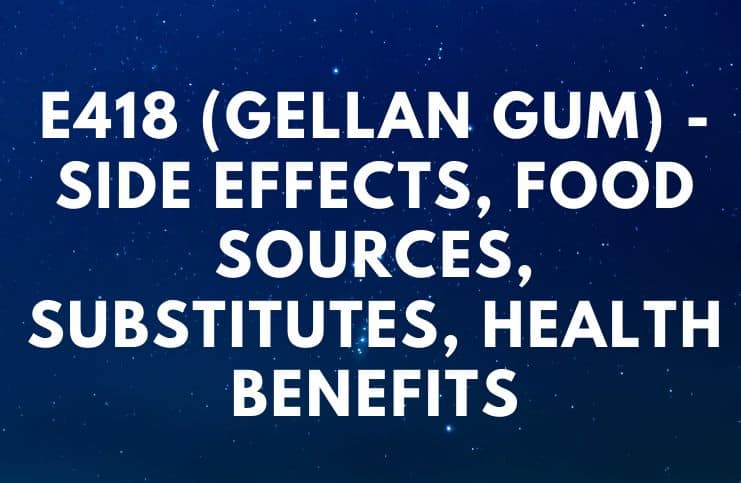E418 (Gellan Gum) – Side Effects, Food Sources, Substitutes, Health Benefits:
E418, or Gellan Gum, is a polysaccharide produced by the bacterium Sphingomonas elodea.
This bacterium was discovered in the 80s in the US and is obtained by fermenting starch. It received full food approval from the U.S. FDA in 1992.
Due to the fact that E418 is stable at temperatures of 120° C and that it takes half the amount of agar, it was used to replace the latter in the composition of the environments needed for the growth of microorganisms, especially thermophilic ones.
It was first introduced in the food industry in Japan (1988). It was subsequently approved for use in food in many countries, including the European Union.
E418 is used as a thickener, emulsifier, stabilizer, and substitute for gelatin in products. It can also be used in sorbet and ice cream recipes which behave as a fluid gel after churning.
It is not cytotoxic (the quality of being toxic to cells) and can be injected into tissues.
Is It Vegan?
Since it is produced from bacteria fermentation, this product can be consumed by vegans and vegetarians. However, gellan gum produced from whey is not vegan.
Food Sources of E418
The most important sources are: dairy products, candy, creams, emulsified fat with or without flavorings, sauces, toppings, dressings, ice cream, processed fruit and vegetables, canned products, meat products, fish, eggs, spices, soup, edible membranes, vegetable protein products, supplements, soy milk, sodas, etc.
Health Benefits
Similar to locust bean gum, this product has also been studied in humans as a potential cholesterol-lowering compound.
It gum was also successfully used for the microencapsulation of temperature-sensitive probiotics such as Bifidobacterium longum ATCC 15707.
Side Effects of Gellan Gum
It has a laxative effect if consumed in large quantities due to the fermentation of intestinal flora. However, its gum is not cytotoxic and can be injected into tissues.
Apart from this, there were no other side effects noticed; however, keep in mind that these tests were conducted on short periods of time (less than a month), and thus, long-term effects are still unknown as they have not been studied yet.
Pregnancy
It is not allowed in foods for infants and young children. It is also advised that pregnant women should avoid foods containing E418.
Substitute
This product can be substituted with xanthan gum, guar gum, and locust bean gum, all similar products which are used to help stabilize, bind, and texturize products.
Xanthan Gum
Both xanthan and gellan gums are polysaccharides made by fermentation of Xanthomonas campestris and Pseudomonas elode.
It is commonly used in foods made with gluten-free flour, where it acts as a gluten substitute of sorts by binding the food together. Xanthan gum, 1 percent, can produce a substantial increase in the viscosity of a liquid.
Moreover, according to a 2009 study, xanthan gum substantially retarded tumor growth and prolonged the survival of mice who had melanoma.
Note – it is accepted as a safe food additive in the European Union, the United States, Canada, and many other countries, with E number E415.
Guar Gum
It is derived from the sap of the acacia tree. Guar is used in ice creams and coconut milk. Also, it is one of the most frequently used binding gums in most baked gluten-free products and gluten-free recipes.
Note – guar gum is more soluble than locust bean gum due to its extra galactose branch points.
Locust Bean Gum
It is a natural food additive that comes from the carob seeds of the carob tree. This type of gum substantially improves gel strength and texture. Locust bean gum occurs as a white to yellow-white powder.
Also, it prevents syneresis when used in combination with carrageenans.
READ THIS NEXT:
What Health Risks are Associated With Lead Poisoning?
Kola Nut – Side Effects, Benefits, Caffeine Content, Allergy Symptoms
References https://www.ncbi.nlm.nih.gov/pmc/articles/PMC2839393/ https://www.ncbi.nlm.nih.gov/pubmed/2253802 https://www.sciencedirect.com/science/article/pii/S2212827117305280
